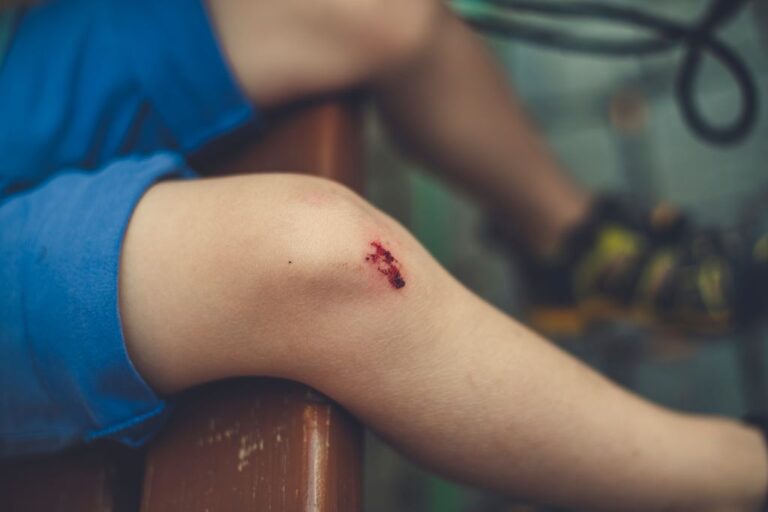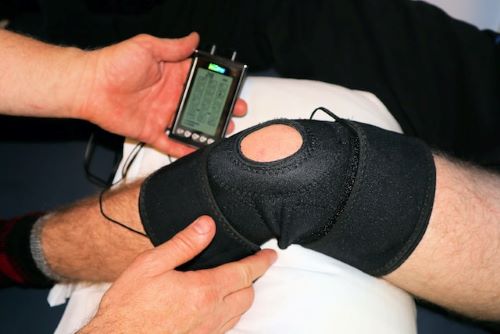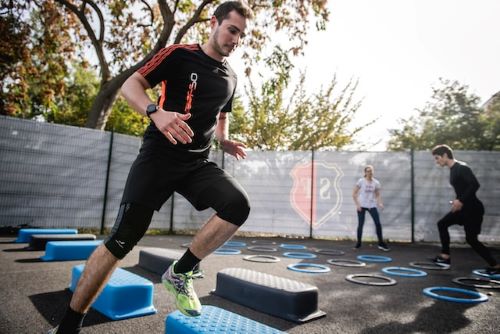Pickleball, just like any sport, is a great hobby that promotes good health and socialization. Pickleball players get to stay fit and have fun in the process, regardless if they are beginners or experts.
However, some of us will experience a bit of discomfort after playing. Pain doesn’t mean permanent injury, so don’t stop playing right away. But it is important to know the ins and outs of injuries—especially if you’re hurting in the knees—and how to avoid them in the future.
Is Pickleball Too Much for the Knees?
Your knees are put under a lot of stress whenever you suddenly jerk or move your legs. Sports such as pickleball and tennis are reliant on sudden movements since you have a small window of time to react to hits and chase the ball around the court.
I wouldn’t call these movements too much for the knees if your body is well-prepared and trained for such movements. However, if you go into a match unprepared but are still ready to do your worst, you certainly could get injured while you are playing pickleball.
Knee Injury Risk for Pickleball VS Other Sports
What differentiates pickleball knee injuries from knee injuries from other sports is the cause. Since there are different biomechanics for different sports, you would expect different causes of injuries as well. However, the injuries themselves are basically the same.
For example in basketball, most knee injuries originate from falling awkwardly after jumping. Jumping is frequently done in basketball, so you always need to be mindful of your landing as well as your footing.
Pickleball and tennis possess similar biomechanics as pickleball is a mix of tennis, badminton, and ping pong. Although it can be argued that tennis requires more running, all these sports involve quick changes of direction and speed. This is why it is more common to get knee injuries through twists of the knee in these types of sports.
Common Pickleball Knee Injuries
When we talk about the knee, we usually focus on the joints, ligaments, and cartilage. There are various possible injuries that your knee could be susceptible to. Let’s look into the most common ones in pickleball:
-
Knee Sprains
This usually happens when you are not properly warmed up before starting a pickleball match. Knee sprains—or sprains in general—are caused by too much stress for a specific body part to handle. This goes for twists, folds, and more.
In a knee sprain, the ligaments stretch so much that they eventually give way. This would lead to immediate swelling and pain. The amount of pain and swelling varies depending on the intensity of the sprain, which also depends on how much your knee was twisted beyond its limit.
A minor knee sprain can take a few weeks to a month to heal while a severe sprain could take two to three months, or maybe even more, depending on the degree of your injury.
-
Osteoarthritis
This injury is extremely common for elderly pickleball players out there. Although young at heart, their knees have inevitably grown weaker with age and therefore will have a harder time withstanding more intense exercises.
What happens is that old and weak joints usually get sore and inflamed after a bit of movement. If you continue to exercise regardless, the cartilage in between the joints will eventually give up and break down. Remember, the cartilage is the one that absorbs the shock and stress that your knees feel. Without it, it is truly painful.
Thankfully, there are four stages to osteoarthritis, so the cartilage won’t break down completely right away.
- Minor – a small breakdown of cartilage; little to no pain in the knees.
- Mild – minor bone spurs will start to occur around the knees; small pain will linger along with stiffness and soreness.
- Moderate – cartilage breakdown becomes significant; significant pain occurs during activities that involve the knees.
- Severe – cartilage is almost worn out completely; constant pain is felt.
You cannot recover from osteoarthritis, because cartilage doesn’t grow back. But you can manage the pain and symptoms to make sure it doesn’t get worse. This is where knowing your limits is important, as well as keeping a healthy diet and going for regular check-ups with your doctor.
-
Patellar Tendonitis
This is also called the “Jumper’s Knee” and for good reason. The patellar tendon is a part of the knee hugely responsible for jumping, specifically the mechanics of bending and straightening. Exerting too much stress on this tendon will result in an injury.
When we play pickleball, we are taught to be on our toes constantly. This enables us to quickly react and pounce in the direction of the ball so that we can counter our opponent’s blows. But the various jumps, hop steps, and sudden directional changes that we have to do place stress on our patellar tendons.
Our patellar tendons can only take so much stress before eventually getting overworked. All it takes is one big movement on a tired knee to cause damage and injury.
So, remember to rest in between matches and play at your pace because even just mild patellar tendonitis takes a month or two to heal. For more serious cases, it usually takes six months to a whole year to actually recover from it.
-
Meniscus Injuries
A torn meniscus is one of the most common knee injuries, not only in pickleball but also in many other sports.
The meniscus is a c-shaped cartilage around your knees. It is responsible for absorbing shock from when your knees rotate and twist. So, it is bound to get hurt whenever you overtwist your knee, and even more so whenever you are tired or lifting heavy weights.
Sports like pickleball require a lot of instant changes in direction and quick jumping. And while your knees are usually equipped to resist the stress that these actions take, there’s a limit. The problem is that pickleball is quite fast-paced, so without doing the proper warm-ups, or if you play while tired, your meniscus will not be able to keep up with all the movements.
Excessive force on your meniscus from sudden and quick turns will most likely tear a worn-down meniscus. A meniscus injury takes 4 to 12 weeks to heal for younger people and 3 to 6 months for older ones.
What To Do If You Have a Pickleball Knee Injury
There are a few things you must know and do when you injure your knee in pickleball.
-
Stop Playing and Get Help Immediately.
If it’s a minor injury, you can get home and rest up first before consulting a health professional. However, if it’s something serious—especially if you have trouble walking—then immediately go to the hospital for diagnosis and treatment.
-
Rest and Recover.
Resting is extremely important when it comes to recovering from injuries. Give your knee enough time to heal. It can only heal if you let it and give it time to repair, so avoid physical activity for the time being or as prescribed by your doctor.
You may even have to excuse yourself from school or work, or attend remotely online, just to let your injury heal. Always wait for the go-ahead signal before getting back to doing physical activities again.
-
Be Diligent with The Doctor’s Instructions.
Being disciplined in your recovery stage helps you recover quicker. Being stubborn does the opposite. Chances are, you won’t heal properly and will end up injuring yourself again somewhere down the line. Follow your doctor’s orders and recommendations—take your meds and vitamins religiously, watch your diet, perform stretches, and apply cold/hot compresses.
-
Rehabilitation Is Important.
You have to ready your knee bit by bit before setting foot on the court again. You can’t use your knee that much while recovering. Though it heals and recovers as the days go by, it also gets weaker. So it is important to strengthen it slowly through rehabilitation exercises.
Injury Prevention Tips: Do’s and Don’ts
All types of injuries can be avoided if you know what to do before, during, and after a pickleball game. As they say: “Prevention is better than cure.”. Here are a few important do’s and don’ts to live by to prevent knee injuries in the future:
-
Warm-Up Properly!
One of the most important things to do to avoid injury and to have an overall better game is to stretch and warm up properly before a game. Warming up helps activate your muscles and loosens up the joints in your body, especially your knees.
This is best done through dynamic stretches and activation exercises that relieve tension in your body. Static stretching is okay, but your body needs to slowly start moving before heading on to the more intense exercises.
-
Get the Right Amount of Sleep.
Preparation and recovery are as important as the game itself. Getting the right amount of sleep—oversleeping doesn’t help!—and eating a proper diet will help you get into tip-top shape always.
Lack of sleep will put you at risk for injuries since your mind will have a hard time aligning with your body movements. It will also lead to bad muscle recovery, messing up the immune system and protein synthesis functions, and more.
-
Eat a Proper Diet.
Nutrition goes hand-in-hand with sleep. Food is the fuel that drives you to work. And just like the fuel of a car, you can’t just put anything in the fuel tank to make it run. It is always best to plan out your diet.
Eat the right type and amount of carbs for energy such as brown rice, protein for muscle building like chicken breast, and more. You could ask for help from a dietician or simply look it up on Google. You’ll want to stay away from soft drinks and other types of junk food, but you don’t have to completely abstain from them. Where’s the fun in that, right? Just don’t make a habit of eating unhealthy food. Everything in moderation.
Maintaining a certain weight also helps. Being too heavy for your knees to carry will definitely increase the risk of injury. There’s no shame in being chonky. Just don’t push yourself beyond your limits. If a movement or action doesn’t feel right, stop doing it.
-
Do Not Force Things.
Knowing your limits is one of the most crucial factors in avoiding injuries in sports like pickleball. It’s great to have a competitive spirit. You get to push yourself to make the most out of every game.
However, it is important to realize that your body can only handle so much. Your mind might say “Yes!”, but if your body says “No!”, don’t push it. There are times when your passion outweighs the fatigue that your body is already experiencing. This usually leads to injuries.
Listen to your body. Remember there will be more games in the future especially if you’re still young and starting out. This is something that a lot of young athletes fail to realize.
-
Avoid Wearing the Wrong-Sized Footwear.
Getting a firm step on the ground is extremely important for shifting your weight around the court. If you slip and lose your balance, you’ll end up falling and possibly overstretching your muscles and tendons. This will definitely lead to an injury—not only to your knees but other parts of your body as well, like your ankles.
Your shoes play a huge role in ensuring a good foothold and balance as you play. Wearing shoes that are too large for your feet will not provide enough support and could cause you to slip. This also stresses out your calves since they have to deal with the unnecessary movements caused by the space between your foot and the shoe.
If your shoes are a bit loose, and you’ve nothing else to wear, try tightening the shoelaces until they fit well around your feet. They should at least fit just right around your ankles. But do not tie them too tightly! Tight shoes could also mess up your game as they put too much pressure on your feet. This could cause inflammation and pain during and after a game.
-
Be Wary of The Court Conditions.
Pickleball courts are typically coated with a surface material that helps make it less stressful on your knees while you play. However, this is not the case for other courts like concrete courts. Solid courts put more stress on your knees and tire them out quickly compared to standard pickleball and tennis courts. This could lead to potential injuries if you decide to push yourself too hard while playing on them.
-
Wear Supportive Gear.
If you are prone to injuries, whether as an elderly or someone with a history of getting injured often, it is recommended that you wear support gear like knee sleeves/supports. These help avoid extra movement on your knees and keep them stable as you play.
Take Care of Your Knees
Knee injuries in pickleball shouldn’t be taken lightly. It is important to first find out what type of injury you have by consulting a medical professional. Then, you can come up with a health plan to recover accordingly.
With that being said, it is still best to avoid getting injured in the first place. Keep your body in good shape by eating a healthy diet and getting the right amount of sleep. Warm up properly before every game or training session. And always know your limits. Remember, there is always going to be a next game, so don’t push yourself too hard if you’ve reached your limits.



 Knee Sprains
Knee Sprains































